Should You Check Oil When the Engine is Hot or Cold?
If you’ve owned a car for even a short length of time, you should be aware that the engine oil level must be periodically checked. That’s because most engines slowly consume (or leak) their lubricating oil. Even your shiny new car will experience some oil consumption over time.
So these questions will likely arise: How do I check the oil level? How often should I do this? Should I check the oil with the engine hot or cold? Engine running or stopped? What if there’s no dipstick? I’ll answer these questions and more.

See Also: 10 Best Places to Buy Engine Oil
How Often Should I Check the Oil?
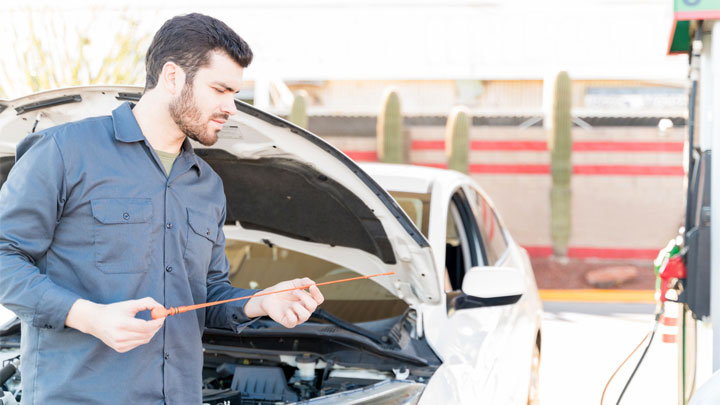
The oil level should be checked periodically, this being largely dependent on how many miles you drive.
- A car driven, say, 1,000 miles per month should have its oil level checked at least once per month.
- A car driven for long trips or business usage of, say, 2,000 miles per month or more should probably have its oil checked at least weekly.
Another approach would be to establish a periodic schedule for oil level checking regardless of miles driven. For example: check the oil level once a week the night before your first drive to work. First day of work is Monday? Check the oil on Sunday night. This would help make this an habitual practice that would not get overlooked.
Many people make it a routine to check their engine oil whenever they’re filling up at the gas pump. The point is, make it a routine.
See Also: How Often to Check Other Car Fluids
When is the Optimal Time to Check Oil Level?
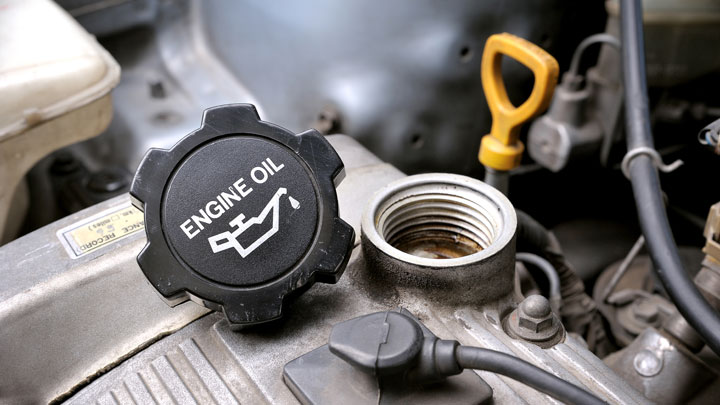
The following conditions generally dictate the best time to check your engine oil level:
Engine Hot or Cold?
Engine cold is generally the best time. A cold engine will be certain to have all its oil drained back to the sump.
A hot engine will naturally have hot oil that could be up to 215° F in temperature. Checking oil level with a hot engine could pose a risk of burns. Be cautious should you choose to do so.
Engine Running or Engine Stopped?
Engine stopped is generally the best time. The running engine is busily pumping that oil around the engine so the oil pan will not be full. An oil check at that time would show too little oil.
There are exceptions to the above rules. Cars with dry sump lubrication systems, for example, will want to have their oil checked with the engine warm and running. The 2021 or newer Corvette C8 LT2 is one such example. Back to the owner’s manual if you are uncertain about this for your vehicle.
Engine Stopped for How Long?
Prior to checking oil the engine should be stopped for at least 5 minutes. This time allows the oil to drain from the engine back into the oil pan. The oil will not cool very much in just 5 minutes so caution is still advised to avoid burnt fingers.
How Engine Oil Works
But first some background. Your vehicle’s engine is lubricated by oil. For most cars built today (whether gasoline or diesel-fueled), that oil is stored in a reservoir called the oil pan (or sump). This pan is located at the bottom of the engine.
During engine operation, a pump picks up the oil in the pan, circulates it first to the oil filter, then to all the areas of the engine that require lubrication, and then back to the pan.
When the engine is shut off, the pump also stops and any residual oil in the engine drains back to the sump. In a nutshell, that’s a typical engine lubrication system.
How Oil Level Is Monitored
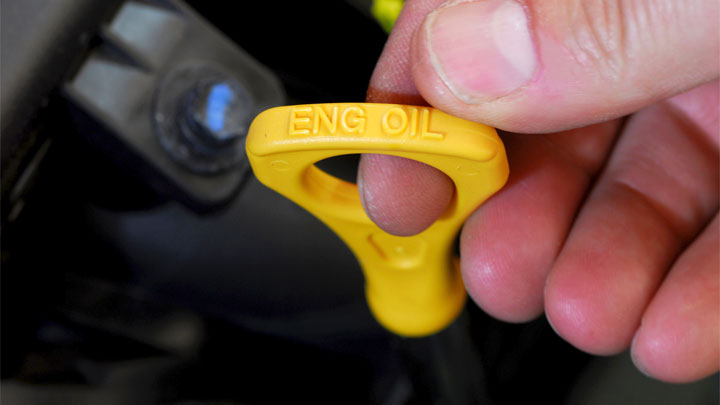
For most vehicles, the oil level can be checked using the dipstick. What is that, you ask? Literally, it is a stick that dips into the oil in the oil pan.
It’s a long slender metal rod (flat or cylindrical) usually with a yellow handle or metal ring on the upper end. It can be found on the top of the engine. If you’re still not sure, check your owner’s manual for its precise location.
The lower end of the dipstick is usually marked with two dots or lines. The upper mark indicates the oil level when the pan is full and the lower mark indicates that the pan is in need of oil.
This lower mark is generally the point where adding precisely one quart will fill the pan back to the full mark.
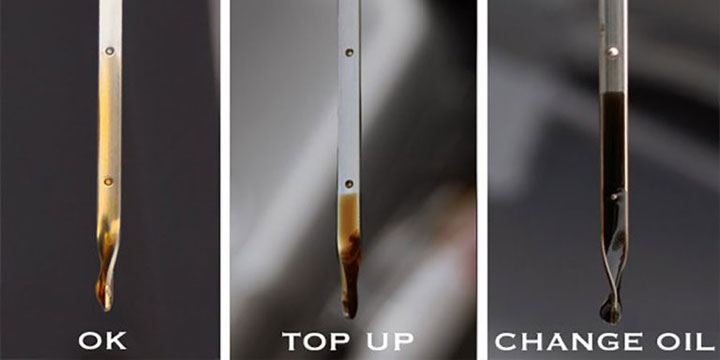
The blank space between these lines may be cross-hatched or simply blank. This in-between area represents the oil level range below full where the engine will have sufficient oil to run properly.
When the oil level is in this middle range, adding oil is not yet required. More detail on how to check the oil is provided below.
See Also: 4 Reasons Why the Low Oil Pressure Light Comes On
How to Properly Check the Engine Oil
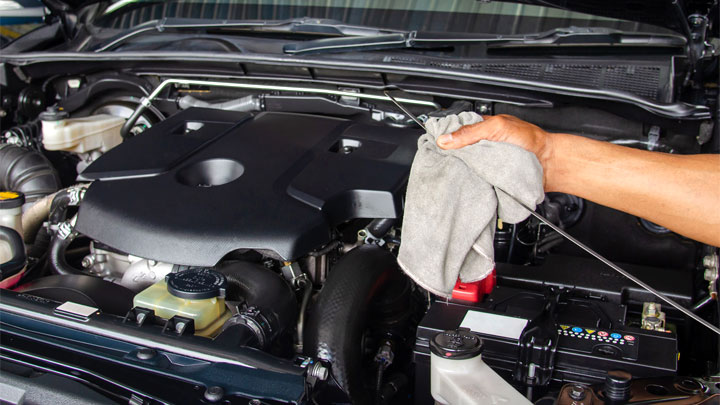
Let’s step through this procedure. You will need a clean shop towel or several paper towels within reach for this job. Having adequate lighting is beneficial as well.
- Park the car on a level surface. This will ensure the oil in the oil pan is level for most accurate measurement. Put the transmission in gear or ‘Park’ and set the emergency brake.
- Open the hood. If the hood does not have gas struts (or is not self-supporting) make absolutely sure the hood support rod is secure in its proper support hole in the underside of the hood.
- Locate the dipstick. Partially withdraw it and stop. Wrap your shop or paper towel around it. Next, withdraw it fully, wiping it dry in the process.
- Insert the dry dipstick back into the dipstick tube. Slide it fully down.
- Again withdraw the dipstick. Do not wipe it this time but hold the towel below its bottom end to catch drips.
- Locate the top edge of the oil on the dipstick lower end. If it’s at the top line on the dipstick the oil pan is full. If at or below the bottom line, adding oil will be required. If it’s in the range between the two lines adding oil will not be essential at this time.
If it’s above the top line, the pan is over full. Some oil must be drained to correct this problem. For more information on this, please review the article located here.
- If the oil level is low, you should address this as soon as possible. Either purchase the correct oil for your car (see your owner’s manual) and add sufficient oil to bring the level to the line (don’t add too much). You will need an appropriate size funnel to enable easy pouring of the oil into the oil fill port. Or go to your preferred oil change shop and have them take the necessary action.
Read Also: Conventional vs Synthetic Blend vs Full Synthetic Motor Oil
Related: Avoid These 4 Common Oil Change Scams
What if Your Car Doesn’t Have a Dipstick?
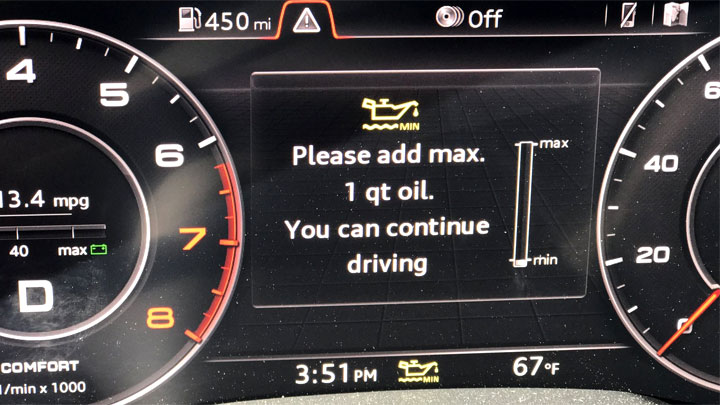
Having no engine oil dipstick in your car is a very real possibility. A number of newer makes and models have done away with this clever reliable feature.
Examples include many BMW models, the new Toyota Supra, some Audis and VWs, as well as several Ford, Lincoln, Chevy, Chrysler and Mazda models.
The list also includes the mid-engine Porsche Cayman. For the Cayman the top of the engine is accessible only from inside the cabin. This makes the no dipstick feature well justified for this particular automobile.
When eliminating the old-fashioned but reliable dipstick, manufacturers have employed complex oil level sensors and circuitry that communicate with the car’s computer. Such systems provide the driver with an oil level indication and in some cases a low oil warning.
Read Also: 3 Signs of a Bad Oil Pressure Sensor
Overall, the reliability of such systems has been reasonably good, but the rare failure to indicate low oil can result in severe engine damage. Should this happen to you, expect a significant repair bill.
You would be wise to check the owner’s manual to ascertain if the car you are driving (or considering buying) is a member of the “no dipstick” club.
- DIY Car Repair Tools – Floor Jack and Jack Stands - Dec 12, 2023
- DIY Car Repair Tools – Socket (Ratchet) Wrench - Nov 9, 2023
- DIY Car Repair Tools – Torque Wrench - Apr 20, 2023
